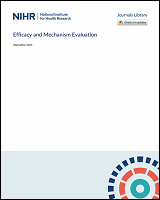NCBI Bookshelf. A service of the National Library of Medicine, National Institutes of Health.
Chappell LC, Bell JL, Smith A, et al. Ursodeoxycholic acid to reduce adverse perinatal outcomes for intrahepatic cholestasis of pregnancy: the PITCHES RCT. Southampton (UK): NIHR Journals Library; 2020 Dec. (Efficacy and Mechanism Evaluation, No. 7.9.)

Ursodeoxycholic acid to reduce adverse perinatal outcomes for intrahepatic cholestasis of pregnancy: the PITCHES RCT.
Show detailsAim
We have had public and patient involvement from before the inception, dating back to the original feasibility study11 for this trial. Jenny Chambers (co-investigator) founded the patient support group, having had lived experience of ICP, including two stillbirths. The aim of the trial was to address the unmet need in finding an effective intervention that reduced the complications of ICP, particularly around adverse consequences for the baby.
Methods
Patient and public involvement has included valued contributions to the design, drafting and revision of the grant application, the protocol, participant information and written material, consideration of means of optimising recruitment while avoiding any sense of coercion at a potentially vulnerable time for women, raising awareness of the trial through publicity on the ICP Support website, review of progress at regular co-investigator meetings, interpretation of the results from a woman’s experience, and much more. We have also had a valued lay member of the Trial Steering Committee (also with lived experience) who contributed actively to discussion and oversight.
In addition, ICP Support produced a short video about the importance of research into ICP, giving the views of women who have had ICP about the need for more research into the condition.30 We have shown this (to great impact) at collaborator meetings.
Professor Williamson runs a biennial course on ICP, unusual in that it is open to women (and their partners) who have experienced ICP, as well as to clinicians and researchers. The talks and discussions are thus held, and women with lived experience contribute to the discussions. We provided two places to every PITCHES site research team to the last conference, mid-way through the trial, enabling us to ensure that patient involvement was front of mind for the researchers and site teams.
Results
Patient and public involvement has been an integral part of all of our pregnancy research for many years, and shapes all aspects from ensuring that we are researching a question that is relevant to women and their families, to considering how pregnant women view participation in research, particularly for a drug trial in pregnancy, when the stakes are high. We used feedback in our newsletters to keep sites aware of the impact of such participation.
Discussion and conclusions
We have little doubt that the trial has recruited to time and target because of the:
- continued importance of the research question to women (as well as clinicians)
- involvement of women with lived experience as core members of the co-investigator and oversight groups
- inclusion of relevant PPI material in newsletters and collaborator meetings
- strong relationships between research teams (e.g. midwives) and women (using methods as described above).
Reflections/critical perspective
The longstanding and deep-seated patient and public involvement in our research programmes has continued to be a theme of this project and is an integral part of its success. There have been many positive aspects to it and we have not encountered any negative sides to this involvement.
- Public and patient involvement (led by Ms Jenny Chambers, ICP Support) - Ursodeo...Public and patient involvement (led by Ms Jenny Chambers, ICP Support) - Ursodeoxycholic acid to reduce adverse perinatal outcomes for intrahepatic cholestasis of pregnancy: the PITCHES RCT
Your browsing activity is empty.
Activity recording is turned off.
See more...